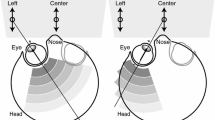Abstract
To obtain the effective components from event related potentials (ERPs), it has been necessary to average the waveforms of several trials. ERP data reflect the psychophysiological state of a subject. Time variation is an important feature in ERP analysis, and so the single-trial method is required. A method is proposed to identify simultaneously both eye fixation related potentials (EFRPs) and reaction related potentials (RRPs) using wavelength transforms. The EFRP is an ERP associated with saccadic eye movement. The RRP is defined as a component similar to P300 gained from the reaction signal. Six subjects participate in the oddball task. The task takes 30 min for each subject. Electroencephalograms (EEGs), electro-oculograms (EOGs) and electromyograms (EMGs) are simultaneously recorded. The EFRP is extracted for the offset of saccade from EOG, and the RRP is extracted for the onset of reaction from EMG. The results show that the estimated waveforms described well each of the components in the EFRP and RRP. Moreover, the simulation results show that the amplitudes of the lambda wave are estimated to within an error of 4%, and those of the latencies are within 0.4%, with an SNR of 4.5dB. Those of P300 were 11 and 4%, respectively. The reliability of the method is proved to be sufficient for estimating ERPs.
Similar content being viewed by others
References
Barret, G., Shibasaki, H., andNeshige, R. (1986): ‘Movement-related cortical potentials, evidence for three slow potential shifts proceeding voluntary movement in man’,Electroencephalog. Clin. Neurophysiol.,63, pp. 327–339
Bartnik, E. A., Blinowska, K. J., andDurka, P. J. (1992): ‘Single evoked potential reconstruction by means of wavelet transform’,Biol. Cybern.,67, pp. 175–181
Bertrand, O., Bohorquez, J., andPernier, J. (1994): ‘Time-frequency digital filtering based on an invertible wavelet transform: An application to evoked potentials’,IEEE Trans.,BME-41, (1), pp. 77–88
Daubechies, I. (1988): ‘Orthonormal basis of compactly supported wavelets’,Comm. Pure Appl. Math.,41, pp. 909–996
Daubechbies, I. (1990): ‘The wavelet transform, time-frequency localization and signal analysis’,IEEE Trans. Inf. Theory, Sept., pp. 961–1005
Goodin, D. S. (1993): ‘Event-related (endogeneous) potentials’,Electrodiagn. Clin. Neurol., pp. 575–595
Hillyard, S. A., Hink, R. F., Schwent, V. L., andPiction, T. W., (1973): ‘Electrical signs of selective attention in the human brain’,Science,182, pp. 177–180
Lim, L. M., Akay, M., andDaubenspeck, J. A. (1995): ‘Identifying respiratory-related evoked potentials’,IEEE EMB Mag., March/April, pp. 174–178
Mallat, S. (1989): ‘Multiresolution approximations and wavelet ortho-normal base ofL 2(R)’,Trans. Am. Math. Soc.,315, (1), pp. 69–87
Marton, M., Szirtes, J., andBreuer, P. (1983): ‘Late components of saccade-related brain potentials in guessing tasks’,Electroencephalogr. Clin. Neurophysiol.,56, pp. 652–663
Morlet, J., Arens, G., Fourgeau, E., andGiard, D. (1982): ‘Wave propagation and sampling theory-part I: Complex signal and scattering on multilayered media’,Geophysics,47, (2), pp. 203–221
Pritchard, W. S. (1991): ‘Psychophysiology of P300’,Psycho. Bull.,89, pp. 506–540
Thakor, N. V., Xin-Rong, G., Yi-Chun, S., andHanley, D. F. (1993): ‘Multiresolution wavelet analysis of evoked potentials’,IEEE Trans.,BME-40, pp. 1085–1094
Thickbroom, G. W., Knezevic, W., Carroll, W., andMastaglia, F. L. (1991): ‘Saccade onset and offset lambda waves: relation to pattern movement visually evoked potentials’,Brain Res.,551, pp. 150–156
Yagi, A. (1981): ‘Visual signal detection and lambda responses’, Electroencephalogr. Clin. Neurophysiol.,52, pp. 604–610
Yagi, A. (1982): ‘Lambda response as an index of visual perception research’,Jpn. Psychol. Res. 24, (2), pp. 106–110
Author information
Authors and Affiliations
Rights and permissions
About this article
Cite this article
Moriyama, Y., Tomita, Y., Honda, S. et al. Simultaneous identification of eye fixation related potentials and reaction related potentials from single-trial signals. Med. Biol. Eng. Comput. 35, 671–676 (1997). https://doi.org/10.1007/BF02510976
Received:
Accepted:
Issue Date:
DOI: https://doi.org/10.1007/BF02510976




